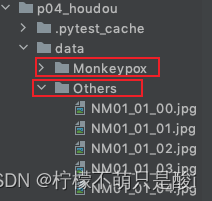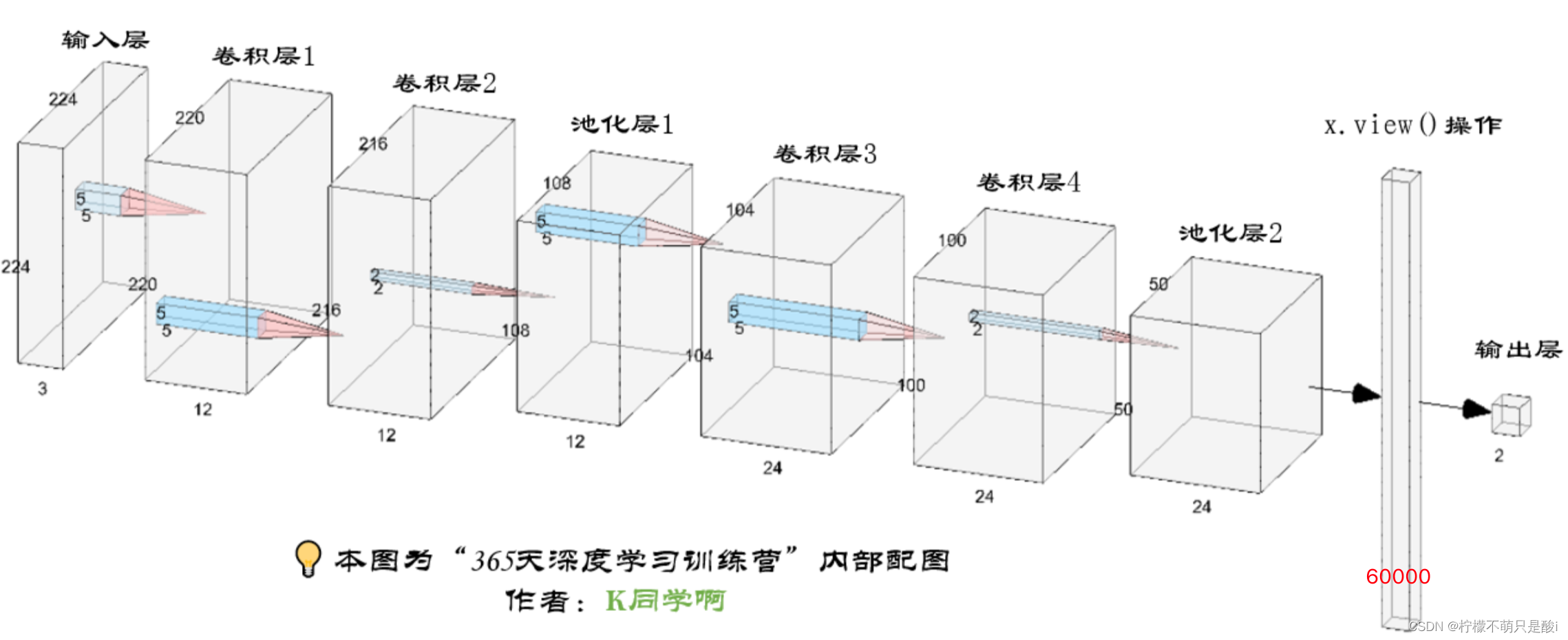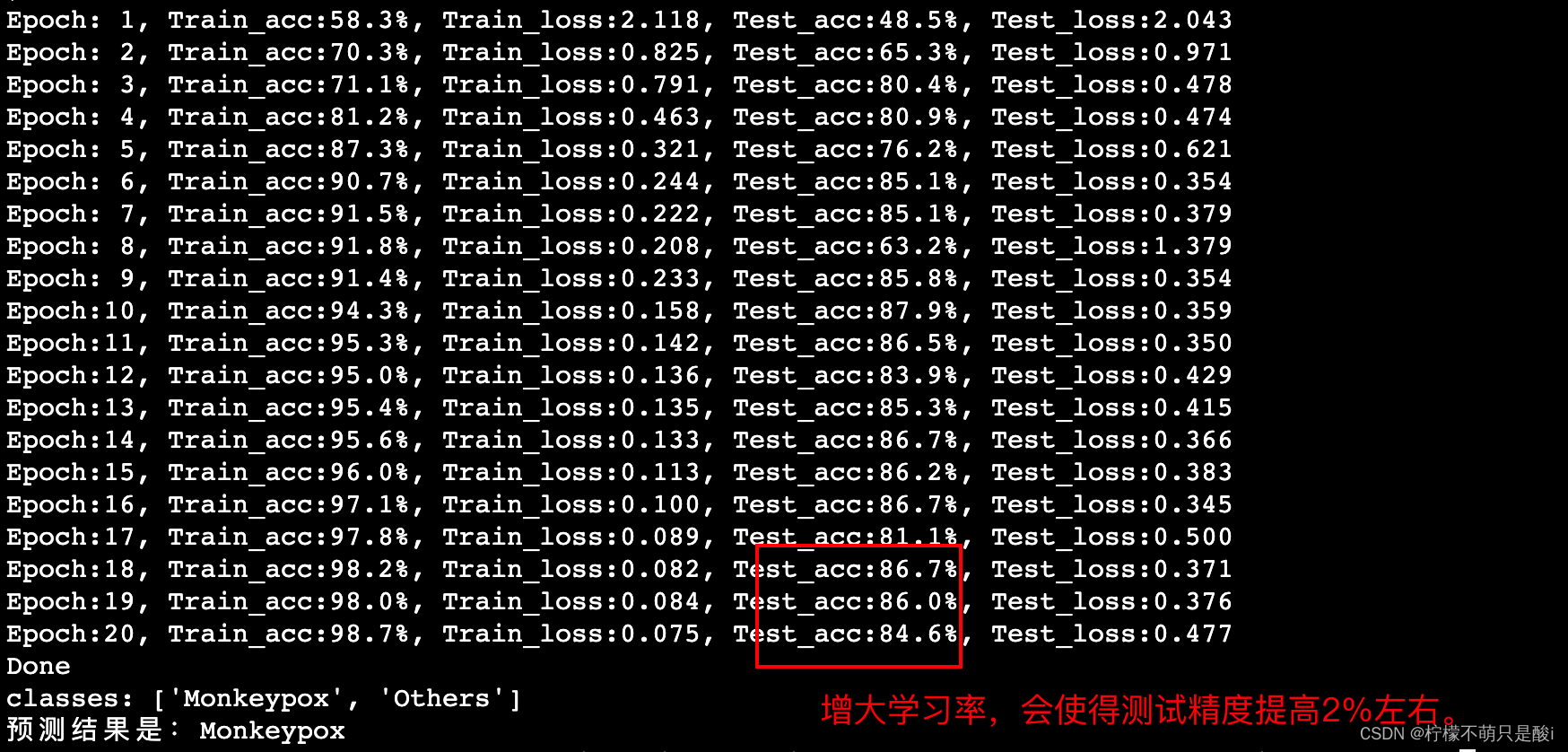本文主要是介绍Pytorch入门实战 P4-猴痘图片,精确度提升,希望对大家解决编程问题提供一定的参考价值,需要的开发者们随着小编来一起学习吧!
目录
一、前言:
二、前期准备:
1、设备查看
2、导入收集到的数据集
3、数据预处理
4、划分数据集(8:2)
5、加载数据集
三、搭建神经网络
四、训练模型
1、设置超参数
2、编写训练函数
3、编写测试函数
4、正式训练
五、可视化结果
六、预测
1、预测函数
2、指定图片进行预测
七、模型保存
八、运行结果展示:
①使用原有的网络模型,测试集的精确度基本上在82%左右。
②在原有网络模型的基础上,添加了relu激活函数,
③减小学习率,
④增大学习率,
- 🍨 本文为🔗365天深度学习训练营 中的学习记录博客
- 🍖 原作者:K同学啊 | 接辅导、项目定制
一、前言:
本篇博文,主要使用猴痘数据集,来训练模型,大部分的代码还是之前的很类似,不同的地方在意,使用的模型参数不同,模型也都是类似的。这篇文章里面,你可以学会如何保存训练好的模型,如何使用保存的的模型进行预测。
如以往一样,可以先大概看下目录,你的脑海会有大概得流程。
二、前期准备:
1、设备查看
# 1、设备相关
device = torch.device('cuda:0' if torch.cuda.is_available() else 'cpu')
print(device)2、导入收集到的数据集
我的数据集文件夹是这样的:
①一个是带有猴痘的图片的文件夹;②一个是其他痘的文件夹;

# 2、导入数据
data_dir = './data'
data_dir = pathlib.Path(data_dir) # 获取到文件data的名称data_paths = list(data_dir.glob('*')) # 获取到文件夹data下面子文件夹的名称 [PosixPath('data/Others'), PosixPath('data/Monkeypox')]
classNames = [str(path).split('/')[1] for path in data_paths] # 获取到子文件夹的名称 ['Others', 'Monkeypox']
3、数据预处理
# 3、数据处理
train_transforms = transforms.Compose([transforms.Resize([224, 224]),transforms.ToTensor(),transforms.Normalize(mean=[0.485, 0.456, 0.406],std=[0.229, 0.224, 0.225])
])total_data = datasets.ImageFolder('./data',transform=train_transforms)
# print(total_data.class_to_idx) # {'Monkeypox': 0, 'Others': 1} total_data.class_to_idx 是一个存储了数据集类别和对应索引的字典。
4、划分数据集(8:2)
# 4、划分数据集
train_size = int(0.8*len(total_data))
test_size = len(total_data) - train_size
train_dataset, test_dataset = torch.utils.data.random_split(total_data,[train_size, test_size])
# print(len(train_dataset), len(test_dataset)) # 1713 429
5、加载数据集
# 5、加载数据集
batch_size = 32
train_dl = torch.utils.data.DataLoader(train_dataset,batch_size=batch_size,shuffle=True,num_workers=1)
test_dl = torch.utils.data.DataLoader(test_dataset,batch_size=batch_size,shuffle=True,num_workers=1)
print('准备工作结束。。。。')三、搭建神经网络
网络图如下:

# 猴痘的模型
class Network_bn(nn.Module):def __init__(self):super(Network_bn, self).__init__()'''默认stride为1; padding为0'''self.conv1 = nn.Conv2d(in_channels=3, out_channels=12, kernel_size=5, stride=1, padding=0)self.bn1 = nn.BatchNorm2d(12)self.conv2 = nn.Conv2d(in_channels=12, out_channels=12, kernel_size=5, stride=1, padding=0)self.bn2 = nn.BatchNorm2d(12)self.pool1 = nn.MaxPool2d(2, 2)self.conv3 = nn.Conv2d(in_channels=12, out_channels=24, kernel_size=5, stride=1, padding=0)self.bn3 = nn.BatchNorm2d(24)self.conv4 = nn.Conv2d(in_channels=24, out_channels=24, kernel_size=5, stride=1, padding=0)self.bn4 = nn.BatchNorm2d(24)self.pool2 = nn.MaxPool2d(2, 2)self.fc = nn.Linear(24*50*50, 2)self.relu = nn.ReLU(inplace=True)def forward(self, x):x = F.relu(self.bn1(self.conv1(x)))x = F.relu(self.bn2(self.conv2(x)))x = self.pool1(x)x = F.relu(self.bn3(self.conv3(x)))x = F.relu(self.bn4(self.conv4(x)))x = self.pool2(x)x = x.view(-1, 24*50*50)x = self.fc(x)x = self.relu(x)return xmodel = Network_bn().to(device)
print(model)四、训练模型
1、设置超参数
# 三、训练模型
# 1、 设置超参数
loss_fn = nn.CrossEntropyLoss() # 创建损失函数
learn_rate = 1e-4 # 学习率
opt = torch.optim.SGD(model.parameters(), lr=learn_rate)
2、编写训练函数
# 2、编写训练函数
def train(dataloader, model, loss_fn, optimizer):size = len(dataloader.dataset) # 训练集大小num_batches = len(dataloader) # 批次数目train_acc, train_loss = 0, 0for X, y in dataloader: # 获取图片及其标签X, y = X.to(device), y.to(device)# 计算预测误差pred = model(X) # 网络输出loss = loss_fn(pred, y) # 计算网络输出与真实值之间的差距。# 反向传播optimizer.zero_grad() # grad属性归零loss.backward() # 反向传播optimizer.step() # 每一步自动更新# 记录acc与losstrain_acc += (pred.argmax(1) == y).type(torch.float).sum().item()train_loss += loss.item()train_acc /= sizetrain_loss /= num_batchesreturn train_acc, train_loss3、编写测试函数
# 3、 编写测试函数def test(dataloader, model, loss_fn):size = len(dataloader.dataset) # 测试集大小num_batches = len(dataloader) # 批次数目test_acc, test_loss = 0, 0# 当不进行训练时,停止梯度更新,节省计算内存消耗with torch.no_grad():for imgs, target in dataloader:imgs, target = imgs.to(device), target.to(device)# 计算损失target_pred = model(imgs)loss = loss_fn(target_pred, target)test_acc += (target_pred.argmax(1) == target).type(torch.float).sum().item()test_loss += loss.item()test_acc /= sizetest_loss /= num_batchesreturn test_acc, test_loss4、正式训练
# 正式训练
epochs = 20
train_loss = []
train_acc = []
test_loss = []
test_acc = []for epoch in range(epochs):model.train()epoch_train_acc, epoch_train_loss = train(train_dl, model, loss_fn, opt)model.eval()epoch_test_acc, epoch_test_loss = test(test_dl, model, loss_fn)train_acc.append(epoch_train_acc)train_loss.append(epoch_train_loss)test_acc.append(epoch_test_acc)test_loss.append(epoch_test_loss)template = 'Epoch:{:2d}, Train_acc:{:.1f}%, Train_loss:{:.3f}, Test_acc:{:.1f}%, Test_loss:{:.3f}'print(template.format(epoch+1, epoch_train_acc*100, epoch_train_loss, epoch_test_acc*100, epoch_test_loss))
print('Done')五、可视化结果
# 结果可视化
warnings.filterwarnings('ignore') # 忽略警告信息
plt.rcParams['axes.unicode_minus'] = False # 用来正常显示负号
plt.rcParams['figure.dpi'] = 100 # 分辨率epochs_range = range(epochs)plt.figure(figsize=(12,3))
plt.subplot(1, 2, 1)
plt.plot(epochs_range, train_acc, label="Training Acc")
plt.plot(epochs_range, test_acc, label="Test Acc")
plt.legend(loc='lower right')
plt.title('Training and Validation Acc')plt.subplot(1, 2, 2)
plt.plot(epochs_range, train_loss, label="Training Loss")
plt.plot(epochs_range, test_loss, label='Test Loss')
plt.legend(loc='upper right')
plt.title('Training and Validation Loss')plt.savefig("/data/jupyter/deepinglearning_train_folder/p04_weather/resultImg.jpg")
plt.show()六、预测
1、预测函数
classes = list(total_data.class_to_idx)
print('classes:', classes)# 预测训练集中的某张图片
predict_one_image(image_path='./data/Monkeypox/M01_01_00.jpg',model=model,transform=train_transforms,classes=classes)2、指定图片进行预测
# 预测函数
def predict_one_image(image_path, model, transform, classes):test_img = Image.open(image_path).convert('RGB')test_img = transform(test_img)img = test_img.to(device).unsqueeze(0)model.eval()output = model(img)_, pred = torch.max(output, 1)pred_class = classes[pred]print(f'预测结果是:{pred_class}')七、模型保存
# 模型保存
PATH = './model.pth' # 保存的模型
torch.save(model.state_dict(), PATH)# 将参数加载到model当中
model.load_state_dict(torch.load(PATH, map_location=device))
(我是在具有GPU的服务器上训练的模型)
八、运行结果展示:
①使用原有的网络模型,测试集的精确度基本上在82%左右。


②在原有网络模型的基础上,添加了relu激活函数,
可使得精度提高2%左右。但是训练精度减少了。


③减小学习率,
使得测试精度,直线下降


④增大学习率,
也可以使得测试精确度提高2%左右,还会使得训练的精确度更好,达到98.7%


这篇关于Pytorch入门实战 P4-猴痘图片,精确度提升的文章就介绍到这儿,希望我们推荐的文章对编程师们有所帮助!





